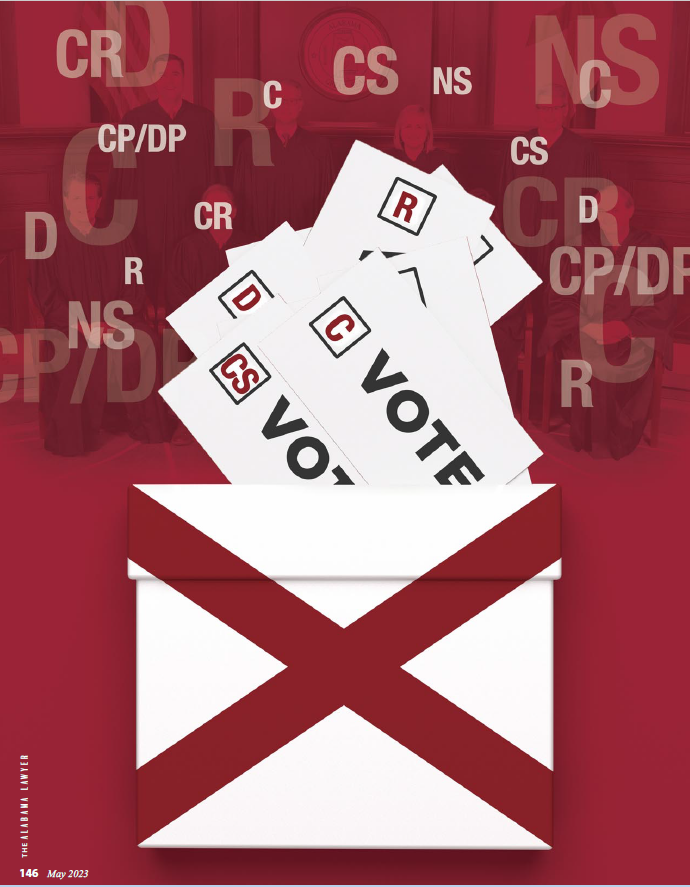How to Read a Vote Line of the Alabama Supreme Court
| Publication year | 2023 |
| Pages | 0147 |

You're hard at work on your brief for an Alabama court. The issue before you is governed by Alabama law, and you've just found an Alabama Supreme Court opinion that is on point.
When you scroll to the bottom of the opinion, you see that in addition to the justice who authored the opinion, three justices concurred and three justices concurred in the result, while two justices dissented. So, seven concurs and two dissents, right? And with this vote line, you can now cite the opinion as the majority opinion of the court and binding precedent in Alabama, right?
Not so fast.
Lawyers should know that not every opinion issued by the Alabama Supreme Court and published in the Alabama Reporter constitutes binding precedent.1 Rather, the doctrine of stare decisis applies only to those opinions in which a majority of the court has expressed agreement on a point of law that is integral to the court's decision.2
There are nine justices on the Alabama Supreme Court, and, at its simplest, this means that an opinion is binding precedent when five or more justices have concurred in that opinion.
But not all types of concurrences are the same, and it's not always as easy as skipping to the vote line at the bottom of an opinion and counting the number of justices whose names appear next to some version of the word "concur." Sometimes, it's not possible to determine what, if any, precedential value an opinion has until after you've carefully read that opinion and the accompanying special writings to discern exactly where the justices' agreement lies.
Path of a Case at The Alabama Supreme Court
To understand the vote line of an Alabama Supreme Court opinion, it's helpful to know the path a case takes when it's filed here. In contrast to the United States Supreme Court - where a justice is assigned opinion-writing duties for a case only after some preliminary discussion and an initial vote - cases filed in the Alabama Supreme Court are assigned to individual justices on a rotating basis after briefing is completed, without discussion or analysis of the case beforehand.
For some extraordinary cases like petitions for the writ of mandamus and permissive appeals filed under Rule 5, Ala. R. App. P., the path is different. These cases are first considered by the court on its weekly miscellaneous docket, at which time the court conducts an initial review to determine whether to accept the case. If a majority of the court agrees to accept the case, the court orders full briefing and, once briefing is complete, the case is assigned to the next justice up in the rotation - unless that justice dissented from the decision to accept the case. In that circumstance, the dissenting justice is skipped, and the case is assigned to the next justice in the rotation who did not dissent from the decision to accept the case.
The justice to whom a case is assigned (or JTWA in court parlance) then works up the case, ultimately drafting either a proposed opinion or a memorandum recommending that the case be disposed of by order without an opinion. (Because orders disposing of a case have no precedential value outside of that particular case, we focus in this article only on cases decided by opinions.) Monthly, these proposed opinions are then circulated to the other justices for review.
Notably, not every opinion is circulated to every justice for a vote. Rather, as set forth in Rule 16, Ala. R. App. P., the court is authorized to consider most cases in five-justice divisions. The court has historically divided itself into two five-justice divisions headed by the two senior associate justices (with the chief justice sitting in both divisions). Most opinions are first circulated only to the other four justices sitting in the JTWA's division, and if the four other justices in that division agree with the JTWA's recommended disposition of a case, the opinion may be released without being considered by the other four justices. But if even one justice in the division dissents, the case is forwarded from that division to the court's monthly general conference, where it is considered by the entire court.
Some opinions are circulated directly to general conference for consideration by the full court. These include death-penalty cases, cases in which the JTWA is recommending that the judgment of an intermediate court of appeals be reversed, disbarment proceedings, and utility-rate cases, among others. Additionally, any opinion deciding a case that was previously considered by the entire court on the weekly miscellaneous docket is circulated directly to general conference. It's the court's policy that once a justice participates in a case, that justice has the right to continue participating until the case is resolved.
Voting
After reviewing the proposed opinions that are circulated, the justices enter their preliminary votes. These votes may change as the justices continue to discuss the case, but eventually, each justice will finalize their vote and that vote will be printed on the vote line at the end of each opinion. These votes can take various forms.
A. Concur (C)
The most common vote is probably "concur." When a justice concurs in an opinion, it is presumed that the justice is in complete agreement with the opinion. The justice authoring the opinion is also counted as a C vote.3
B. Concur specially (CS)
A justice concurs specially when the justice agrees with everything in the main opinion but wants to write separately to make some additional point. For example, a justice may want to...
To continue reading
Request your trial
